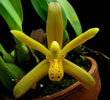|
|
|
|
|
| |
Flasks of
Maxillaria rufescens 'MC2223' × self |
|
| |
|
|
| |
| Number: |
TN3907 |
| Name: |
Maxillaria rufescens 'MC2223' × self
|
| Type: |
self (What's that?) |
|
Seed Donor: |
Dale Borders
|
|
Click to Enlarge

Pod Parent Flower |
|
|
|
| |
Culture Notes from Donor: Parent plant: Temperature range I (60-83°F)
For additional origin/habitat information supplied courtesy of
Charles and Margaret Baker, see further below, near the bottom of this page.
|
Temperatures we attempt to use in the lab & greenhouse:
| For Species: |
|
Spring, Summer, Autumn, Winter: days average 79°F, nights 62°F; best fit is Intermediate 83-60°F
(Source:
Baker's Web OSC) |
|
About the name...
| Etymology of |
Maxillaria |
|
From Latin "maxilla" jawbone.
(Source:
Pridgeon 1992) |
| Etymology of |
rufescens |
|
From Latin "rufescens" light fox-red.
(Source:
Mayr & Schmucker 1998) |
| Pronunciation of |
Maxillaria |
|
max-ill-AIR-ee-a
(Source:
Pridgeon 1992) |
|
If you would like to direct someone to this web page, please copy and paste this URL into your email:
http://troymeyers.com/d?013907
| Flask Information |
| Availability: |
Capsule failed. We were not able to make any flasks. |
| You should: |
Consider placing a "Notify Retries" Request, and if an identical pollination (the same parents) is done again, we'll let you know. |
|
You might also want to:
|
View items of the same species.
View items of the same genus.
|
| Ordering Information |
| You are not currently logged in. |
|
You must be a registered user and be logged in to reserve a flask or place a notification request. Please log in:
|
|
|
|
|
|
| |
The origin/habitat information below is supplied courtesy of Charles and Margaret Baker
The following information is based on the name of the plant provided by the donor, and assumes that the name is correct. If the plant has been misidentified, then the following information may not be correct.
This text is copyrighted by the Bakers and may not be reproduced without permission.
ORIGIN/HABITAT: Northern South America including Ecuador, Peru, Bolivia,
Brazil, Venezuela, the Guianas, and Trinidad. Plants have been incorrectly
indentified with other species, so only collections that were reported by
w3 Tropicos (1999) as Maxillaria rufescens. In Ecuador, numerous
collections are made throughout the country, especially along the eastern
slopes of the Andes and in the Amazon Basin. Plants grow in
Mornona-Santiago Province at 2300-4900 ft. (700-1500 m), in Napo Province
at 750-1800 ft. (230-550 m), in Tungurahua Province at 4250-6550 ft.
(1300-2000 m), and in Zamora-Chinchipe Province at 3300-4900 ft.
(1000-1500 m). In Peru, plants are found in the Department of Huanuco at
1950-2300 ft. (600-700 m) and in the Department of Loreto at 800-1150 ft.
(250-350 m). In Venezuela, collections were made in the Amazonas
Territories at 250-3950 ft. (80-1200 m). Plants grow on trees in regions
with very wet forests.
Earlier works report that this species was also found in Central America,
the West Indies, and northern South America. This is now considered highly
suspect, and the error probably occurred when the habitats of several
similar but distinct species were merged. This is why Maxillaria
acutifolia Lindley is sometimes listed as a synonym of Maxillaria
rufescens Lindley. Dressler (1993), however, treats both Maxillaria
rufescens Lindley and Maxillaria acutifolia Lindley as valid and separate
species and commented that, "This name (Maxillaria rufescens) has been
applied to many superficially similar species, including Maxillaria
acutifolia and Maxillaria hedwigae. It may be that none of the Central
American plants is really Maxillaria rufescens." Ackerman (1995) reports
that Caribbean plants previously known as Maxillaria rufescens var. minor
should be called Maxillaria acutifolia.
The locations recorded specifically for Maxillaria rufescens listed by w3
Tropicos (1999) does not include any plants outside of northern South
America Ecuador, Peru, and Venezuela.
More about this information and the Bakers...
|
|
|
| |
|
|
|